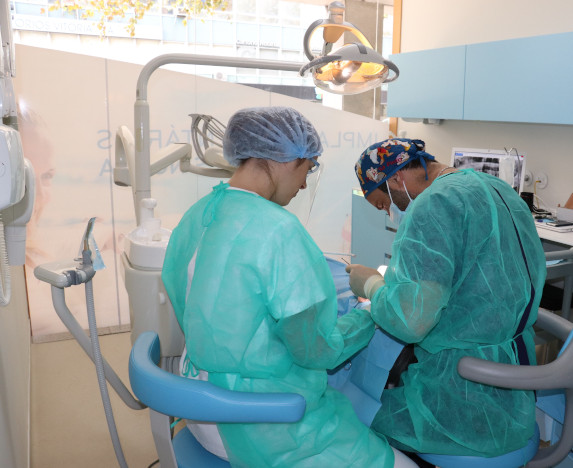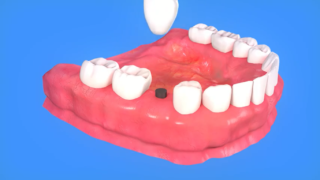
Dental implant surgery is a medical procedure that intends to restore teeth in toothless patients. The implants are comprised of small metallic screws in the shape of threads that replace the roots of the missing teeth. The titanium screw is then attached to a crown, and the abutment connects both. The crown is exactly the same as the missing tooth and is made of porcelain. The new artificial teeth are similar to natural teeth in terms of function and appearance.
Dental implant surgery is performed according to the condition of the jaw. It is used in cases where the person has lost one or more teeth or when the person has no teeth. Dental implant surgery involves many procedures and stages. It is a common and safe procedure used all over the world. Ever more often, people with no teeth seek a permanent solution that is an alternative to removable dentures.
Implant Surgery step by step
Pre-surgical planning – X-ray study
A meticulous pre-surgical planning will determine the success of the implant surgery. The planning involves the study of imagery – 3D X-Ray’s. With this study, it is possible to determine the position, size and angle of the implants. The clinical record of the patient must be known, and a CT Scan and other exams are essential to the success of the treatment.
The pre-surgical planning made by studying the X-rays allows for the assessment of the dental arches and of the adjacent anatomical structures, such as the joints between the gums and the skull and the maxillary sinus.
If the general condition is deemed adequate, the dental surgeon shall explain to you the entire procedure step by step, namely the surgery, the integration, the post-op period, the final recovery and post-surgical care. If you have any questions about your treatment, talk to your implantologist and ask all your questions on the treatment. At this first stage, it is important that you are clarified on all your questions regarding dental implant surgery and the stages that are to take place before undergoing treatment.
How should one prepare for implant surgery?

Do not drink any alcoholic beverages on the day of the surgery or the day before;
You should eat before the surgery but not in excess. Light foods are the most suitable;
Avoid physical effort on the day of the surgery;
If possible, have a friend or relative accompany you and please show up a few minutes early on the scheduled date;
Use comfortable clothes on the day of the surgery;
Thoroughly brush your teeth (if applicable) and your tongue, use dental floss if necessary;
Possible treatments before or during surgery.
- Extraction of one or more teeth. Should there be a need for extraction, the procedure shall be performed before or during the surgery. It is possible to extract a tooth and insert an implant in its place. In case of swelling or gum disease, the tooth is extracted some weeks earlier;
- Maxillary Sinus lift. A maxillary sinus lift is a surgical procedure used when there is not enough bone structure at the time, on the upper jaw. When bone loss is severe, there should be a waiting period before the surgery.
- Bone grafts. Bone grafts are used to thicken or increase the amount of bone in the jaw in cases where it is very thin and insufficient.
What happens during the implant surgery
The implant insertion procedure, from the surgery to the placing of a crown, varies according to each medical case. Procedures such as extraction or the use of biomaterials, bone grafts or maxillary sinus lift can be performed during or before the surgery.
1st Stage – Inserting the dental implant
Local anaesthetics are used so the surgery can be totally painless. The destroyed tooth is removed (if applicable). The maxillary bone is prepared and, if necessary, bone augmentation techniques are used. A metal pivot is inserted in the maxillary bone under the gum.
2nd Stage – Inserting the implant in the bone
During the implant surgery, the dentist will make a small incision in order to expose the bone. With the aid of previously calibrated drills, the dentist will insert the pivot into the defined spot. Surgical procedures are conducted with the aid of local anaesthetics.
3rd Stage – Adjust and protect the implant
The area of insertion of the implant is ready, the implant is inserted in the maxillary bone. A lid is placed to protect it from foods and parts of organic tissue.
4th Stage – Suture
The intervention area is sealed with a suture thread. The suture thread will help close the wound and isolate the implant. The suture thread will remain in place for a few months so that integration can take place.
Implant integration

The implant integration takes a few months, from 3 to 5. During that integration period, the cells of the maxillary bone will cover the titanium surfaces The waiting time will depend on the person and on the medical case. This process is called bone integration and respecting the waiting period is extremely important. An implant that is strongly anchored in the bone will determine the success of the treatment.
The final prosthetic restoration and your new tooth
The dentist will remove the lid from the implant and place the scaring pillar, which is an extension of the small cylinder. This will help in the process of shaping and scaring of the gum. The gum is ready to received the new artificial tooth.
The dentist will assess your mouth using plaster models. The models are in the shape of your mouth, to study the occlusion. The colour and material of the new tooth will then be chosen. Finally, the crown of the new artificial tooth is bolted onto or cemented to the implant.
Post-surgical care
- Take the medicine prescribed by the dentist;
- Apply ice to the face for at least 15 minutes but do protect the skin with a soft cloth;
- Do not smoke or drink alcohol;
- Avoid prolonged sun exposure;
- Sleep with your head lifted up or turned to the opposite side of the surgery area;
- Don’t exercise on that day or the following day;
- Be careful with hard foods that may hurt the surgery area. Favour soft and cold foods, such as ice cream, soups and porridge. On the third day after surgery, regular food can be introduced;
- Post-surgical care with the implant.
After dental implant surgery, post-surgical care will determine the longevity of your treatment. Oral hygiene, frequent brushing, the use of mouthwash and dental floss will ensure that the treatment lasts for many and many years. Follow the instructions provided by your dentist, ensure a thorough and frequent oral hygiene and do not miss maintenance appointments once or twice a year.
Conclusions on implant surgery
Dental implant surgery is more and more frequent and is a simple procedure. The process is entirely painless because of the use of appropriate anaesthetics. In order to extend the effects of your treatment, it is fundamental that you practice a thorough daily oral hygiene. Visit your dentist regularly to make sure the implant is working appropriately. Avoid harmful habits like chewing very hard foods, such as hard candy, as it could damage your new dental crowns. Avoid smoking, since it can contribute to potential complications. Healthy life habits are key to good health and well-being and essential factors in increasing the longevity of your dental treatment.
Scientific source and studies
- Cox JF, Zarb GA. The longitudinal clinical efficacy of osseointegrated implants: a 3-ear report. Int J Oral Maxillofac Implants 1987: 2: 91-100.

